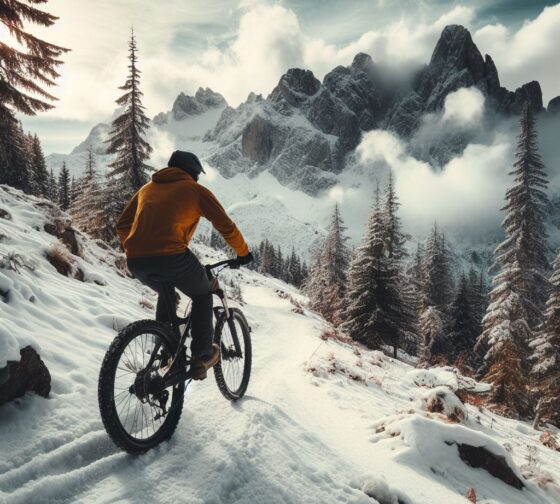Snow Bike Adventures: Embrace the Winter Trails!
*We may earn a commission for purchases made using our links. Please see our disclosure to learn more.
Exploring the World of a Snow Bike
As a passionate cyclist, I’ve always been on the lookout for new and exciting ways to enjoy two-wheeled adventures. One winter activity that has captured my heart is snow biking. In this article, I’ll guide you through the fascinating world of a snow bike, sharing valuable insights, suggestions, and reasons behind them.
The Thrill of Snow Biking
Snow biking is not your typical cycling experience. It combines the joys of mountain biking with the serene beauty of winter landscapes. Riding a snow bike allows you to explore snowy trails and remote areas that are inaccessible on foot or with traditional bikes. The experience is nothing short of exhilarating.
Choosing the Right Snow Bike
Selecting the right snow bike is the first step in your snow biking journey. There are a variety of options available, including fat bikes, snow-specific models, and mountain bikes adapted for snow riding. Each has its own set of advantages and disadvantages, so it’s essential to choose one that suits your preferences and the type of terrain you plan to conquer.
Essential Gear for a Snow Bike
Before embarking on your snow biking adventure, it’s crucial to invest in the right gear. The combination of cold temperatures and challenging terrain demands proper clothing and equipment.
Winter Apparel
Your clothing choice is vital to staying comfortable during your ride. Layering is key to regulating body temperature. Start with a moisture-wicking base layer, add insulating layers, and finish with a waterproof and windproof outer shell. Don’t forget warm gloves, a thermal hat, and high-quality winter boots.
Snow Bike Types
Different snow bike types are designed for various conditions. Fat bikes are excellent for soft and deep snow, while snow-specific bikes often come with wider tires and specific features. Assess your local terrain and weather to determine the most suitable option.
Tire Selection
Choosing the right tires is essential. Studded or non-studded tires offer varying levels of traction. Studded tires are ideal for icy conditions, while non-studded ones are better for packed snow. Consider having both options if you plan to tackle diverse terrains.
Preparing for Your Snow Bike Adventure

Snow biking requires preparation beyond just acquiring the right gear. Maintaining your bike, adhering to safety guidelines, and learning riding techniques are equally important.
Bike Maintenance
Regular bike maintenance is vital to ensure your snow bike performs optimally. Pay close attention to your drivetrain, brakes, and tire pressure. Lubricate moving parts and clean your bike after each ride to prevent snow and ice build-up.
Safety Considerations for a Snow Bike
Snow biking poses unique safety challenges. Always inform someone about your ride plans and expected return time. Carry essential safety gear, including a first-aid kit, navigation tools, and a communication device in case of emergencies.
Riding Techniques
Snow biking involves different riding techniques compared to traditional cycling. Learn how to handle your bike on slippery surfaces, including making controlled slides, navigating corners, and descending safely. Practice these skills in a controlled environment before venturing into the backcountry.
Top Snow Biking Destinations
Now that you’re prepared, it’s time to explore some of the most picturesque snow biking destinations.
Popular Snow Biking Locations
Several regions around the world offer incredible snow biking opportunities. Places like the Canadian Rockies, Nordic countries, and the Rocky Mountains boast extensive networks of snow-covered trails.
Ideal Weather Conditions
Timing your snow biking adventure is crucial. Aim for days with fresh snowfall or when trails are well-maintained. Avoid days with extreme cold, strong winds, or heavy snowstorms.
The Benefits of a Snow Bike
Aside from the sheer joy of snow biking, there are several other compelling reasons to give it a try:
Physical and Mental Health Benefits
Snow biking provides an excellent cardiovascular workout, helps strengthen your lower body muscles, and enhances your balance and coordination. The beauty of the winter landscapes also contributes to stress reduction and an overall sense of well-being.
Eco-Friendly Winter Transportation
Choosing snow biking over gas-guzzling vehicles reduces your carbon footprint. It’s a sustainable and eco-friendly mode of winter transportation, contributing to a cleaner environment.
Challenges and Solutions
While snow biking is undoubtedly exhilarating, it comes with its set of challenges. However, with the right mindset and preparation, you can conquer them.
Overcoming Snow Biking Challenges
Challenges may include varying snow conditions, trail obstacles, and physical exertion. By continually improving your skills and staying adaptable, these challenges can be overcome.
Tips for Enjoyable Snow Biking
To ensure your snow biking experience is as enjoyable as possible, remember to take breaks, stay hydrated, and respect the environment. Leave no trace, be courteous to other trail users, and always prioritize safety.
Conclusion
Snow biking is a fantastic way to embrace the winter season while staying active and exploring stunning snowy landscapes. With the right gear, proper preparation, and a positive attitude, you can make the most of this exhilarating activity. So, grab your snow bike and get ready for an adventure like no other!
FAQs About a Snow Bike
- Is snow biking suitable for beginners?
- Snow biking can be enjoyed by both beginners and experienced cyclists. However, it’s essential to start on easier trails and gradually progress to more challenging terrain.
- What is the best time to go snow biking?
- The ideal time for snow biking is during or shortly after fresh snowfall. Avoid extremely cold or windy days for a more enjoyable experience.
- Can I use my regular mountain bike for snow biking?
- While it’s possible to adapt a regular mountain bike for snow biking, it’s recommended to use a dedicated snow bike or a fat bike for the best results.
- Are there any specific safety precautions for snow biking?
- Yes, snow biking has unique safety considerations. Always let someone know your plans, carry essential safety gear, and be aware of the weather and terrain conditions.
- Is snow biking environmentally friendly?
- Yes, snow biking is an eco-friendly mode of transportation during the winter months. It produces zero emissions and helps reduce your carbon footprint.




